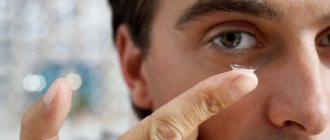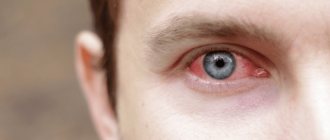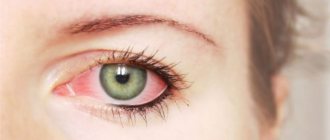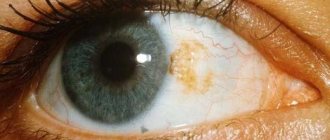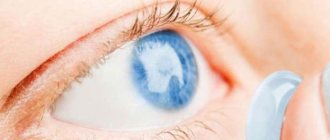To make the holiday fun and without consequences, there are several important rules that you should learn about in advance. Let's figure out which garland is safer for your eyesight, how to save yourself if a champagne cork gets into your eye, and what to do with reddened eyes the morning after a noisy corporate party. Girls, here are some tips for you about contact lenses and eyelash extensions to help you shine at the party.
We are drawing up New Year's instructions for healthy vision together with the chief physician of the Ophthalmological Center of Karelia, Candidate of Medical Sciences Pavel Cheslavovich Zavadsky:
— On New Year's Eve, I congratulate our readers, our patients and their loved ones on the upcoming holiday. On behalf of myself personally and our entire team of specialists, I wish everyone spiritual well-being, harmony in everything, the inevitable achievement of their goals, the fulfillment of all desires and, of course, good health. The Ophthalmological Center of Karelia will do everything possible for the health of your vision!
What to do if a spark from a sparkler, a spruce branch, or a champagne cork flies into your eye?
— The listed eye injuries are the most common pathology on New Year’s weekend. Scale from a sparkler that gets into the cornea is accompanied by redness of the eye, lacrimation, and a feeling of a foreign body. Independent attempts to extract scale are in most cases unsuccessful. The help of a specialist and the subsequent use of eye drops are necessary.
Superficial injuries to the eye from a spruce branch or anything else lead to corneal erosion. This may additionally be accompanied by a significant decrease in vision. Fortunately, this pathology goes away quite quickly - in 1-3 days. However, specialist help and preventive use of eye drops are also necessary.
Blunt injuries to the eye with a champagne cork are always a very serious pathology, which is accompanied by significant damage to all structures of the eye. In some cases, complete or partial loss of vision occurs and urgent surgical treatment is required. I urge everyone to be especially attentive and careful so as not to spoil the holiday for yourself and your loved ones.
Scale got into the eye: algorithm of actions
Symptoms
Home > Symptoms > Scale got into the eye: algorithm of actions.
We'll tell you what to do with scale that gets into your eye: how you can try to get it out, what you definitely shouldn't do, and how you can speed up the healing process.
If shavings from an angle grinder get into your eye, it means that the organ of vision is exposed to three negative effects at once:
- Mechanical injury: flying off at speed, a foreign body disrupts the integrity of one or more layers of the eye.
- Thermal burn: chips entering the eye are heated, which further damages the structures of the eye.
- Chemical reaction of metal and intraocular fluid: when scale from a grinder gets into the eye, and it is in a saline solution of tear fluid, after a while rust appears around it, further impairing vision.
The first question is not how to get the scale out of the eye, but how to minimize the thermal burn. This can be done by rinsing the eye with cool water from a syringe, clean syringe or dropper. Water should be boiled or bottled; you can also use a sterile sodium chloride solution.
When rinsing, it is important not to create increased liquid pressure on the eye, but to direct the liquid in a weak stream - from the outer corner of the eye towards the nose. This is so that if the scale becomes fixed in the eye structures, you will not dislodge it with water.
Rinsing with a cool liquid not only cools the eye and reduces the depth of the burn. It also helps in how to get scale out of the eye if it is not fixed in the tissues.
What should you do if even after washing your eyes you still see shavings? Open your eye and look in the mirror, do the following:
- Blink a little (without effort) and assess whether the foreign body moves;
- if it changes its position, you can try to remove it;
- If the scale does not mix on the surface of the eye, you need to contact an ophthalmologist.
Let's talk about how to get metal shavings out of your eye if they move when you blink:
- take a small piece of gauze, a clean handkerchief or a cotton swab;
- Fold the handkerchief or gauze into a triangle to form a fairly rigid angle;
- do not wet either the napkin or the cotton swab;
- stand in front of the mirror;
- open your eyes wide;
- try to carefully pry up the shavings with the edge of a scarf, napkin or cotton swab;
- remove the foreign body from the eye;
- if it doesn’t work, repeat it all over again, first checking the mobility of the chips.
You can try to remove loose scale with a magnet. But after this, an examination by an ophthalmologist is also necessary.
How can you get the chips out of your eye if they are tightly fixed? To do this, you just contact an ophthalmologist. It is not recommended to use magnets or sharp objects at home. This can damage the deep structures of the eye, and they will heal with scarring or the formation of a cataract, which will lead to loss of vision.
Actually, it's not very simple. If you don't follow the rules, you can harm yourself even more.
So, if there is fixed scale in the eye, what to do at home:
- Close the affected eye, but do not squint it.
- Place a gauze bandage or clean cloth over the eye.
- Secure the bandage with a bandage - carefully so that the strips of the bandage do not put pressure on the eye.
- Go to a hospital where there is an eye trauma department. During the daytime, you can go to the clinic at your place of residence or to a private ophthalmology clinic if operations are performed there. It’s not worth going to a private eye doctor who specializes in vision correction.
If a metal foreign body is not just fixed to the surface of the eye, but also caused damage to the eyelid (that is, it is a penetrating wound), the algorithm will be different:
- Do not try to get a foreign body under any circumstances;
- First cover the eye with gauze or a clean cloth, and place a dense object such as a deodorant cap on top;
- tape the eye over the lid;
- call an ambulance;
- cover the other, healthy eye with a gauze bandage (this is necessary so that the diseased eye does not move along with the healthy one and is not damaged even more).
We found out what to do if chips get into your eye. Now let's list what you can't do:
- rub the eye;
- squint;
- try to get the scale out with a sharp object;
- rinse the eye if the wound is through;
- drip any drops before examination by an ophthalmologist;
- Use a magnet to remove fixed chips.
After the foreign body has been removed on your own, go to an ophthalmologist - maybe even one who sees you in a private office.
He will examine the eye under magnification (using a slit lamp) to make sure that the integrity of the deep structures is not damaged. After that, he will schedule the treatment.
Before this, it is not recommended to use any drops or gels: they should not be allowed to get into the sclera or aqueous humor.
After the doctor is sure that the cornea has suffered minimal damage and other structures remain intact, he will prescribe the treatment. It usually includes antibiotics - in the form of drops or tablets.
The drug Korneregel can also be used to speed up healing. This is a gel containing an analogue of the vitamin pantothenic acid, which is necessary for the formation and regeneration of the eye membranes.
Thus, we looked at what to do if there are metal shavings in the eye: first aid, prohibited actions, and the procedure for going to the hospital.
Links:
1 Korneregel Reg. beat P N015841/01 dated 09/30/2009
There are contraindications. It is necessary to consult a specialist
RUS-OPH-CRN-OCU-11-2018-1394 Take the vision test
There are contraindications, you must read the instructions for use or consult a specialist
Terms of use of the site
Bausch Health LLC
Which garland is safest for eyesight?
— The human eye is a unique organ. People are able to distinguish 2.5 million colors and their shades. Absolutely any visible light from garland lamps is by and large safe for the eyes. The festive atmosphere can be safely complemented by illumination in constant or flashing mode. Attention to this should be paid only to people with a number of neurological diseases. I would also like to note the potential risk to the retina posed by laser pointers. Parents should remember that a laser pointer is not a children's toy.
What next for the patient?
The case when chips from an instrument enter the eyelid is considered to be mechanical damage. The following types of injuries are distinguished by severity:
- light. Vision does not disappear, no visible defects will make themselves felt;
- average. There is slight external damage to the eyelid, vision is reduced, but not greatly;
- heavy. The eye practically cannot see, structural defects appear.
After shavings or crumbs from a grinder get into the eyelid, the following symptoms occur:
- increased tearing of the eyelid;
- pain in the area of injury;
- redness of the eyelid;
- spontaneous closing of the eyelids due to chips, it becomes very difficult to open them;
- impaired vision.
Based on the above signs, it is impossible to reliably determine the degree of damage to the eyes from grinder shavings. This is done by an ophthalmologist using a special microscope. Similar signs make themselves felt after removing shavings from the instrument, the only exception being the increased secretion of tears from the eyelid.
The reason for this is swelling, especially if the chips have penetrated much deeper than the initial layer of the epithelium.
[vote2x id=”2909" align=”center”]
Iron oxide, once in the patient's eye, attaches to the surface of the cornea, then it undergoes a process of oxidation and rusts. The cornea in the area of injury becomes brown.
It is very difficult, even impossible, to remove a foreign body from the eye on your own. The only thing that can be done before providing ophthalmic care is to carry out a number of manipulations:
- Rinse the eye under cold running water (procedure duration – 15-20 minutes).
- Apply eye drops containing an antiseptic.
- Place a compress in the form of gauze soaked in cold water or a chilled tea bag on the eyelid of the damaged eye. Alternatively, you can use half a washed, peeled potato or simply immerse your face in a bowl of cool water.
- Secure the compress with a bandage and apply a patch on top.
- Contact your doctor.
Carrying out the above measures is, in fact, first aid for eye injury.
Did a speck, eyelash or scale get into your eye? Do not do the following to avoid complicating the situation:
- eye rubbing;
- frequent blinking;
- squinting of the eye;
- instilling aloe juice, honey and other folk remedies into the eye.
The doctor removed scale from the eye. What to do next? It is necessary to undergo anti-inflammatory treatment. For this purpose, ophthalmologists prescribe antibacterial drugs, as well as non-steroidal anti-inflammatory drugs. The course recommended by experts lasts five days. You can use antibacterial drugs in ointment form. In case of deep scale, the doctor prescribes NSAIDs orally.
The healing process of the cornea usually takes 7-14 days. There are frequent cases of the formation of epithelial translucent opacities. If a foreign particle is localized in the center of the cornea, we can talk about decreased vision.
What if first aid for an eye injury is not provided? What can the patient's inaction cost him? The consequences of this may include:
- cicatricial deformation of the eyelid on the affected eye;
- eyelash growth in the wrong direction;
- inability to fully open the affected eye;
- fusion of eyelids;
- adhesion of the lacrimal ducts;
- the appearance of “blurred vision”;
- decreased vision;
- dry eye syndrome;
- ocular cataract;
- inflammatory process of the eye structures, which causes partial loss of vision;
- glaucoma – increased intraocular pressure;
- active formation of rust near a foreign particle - a change in the color of the eye structures.
Therefore, scale in the eye and normal functioning of the eye are incompatible things. Such an injury requires immediate consultation with a doctor.
At risk for the described eye injury are people who regularly use a welding machine or grinder in their work and everyday life. Scale in the eye is a serious problem that threatens the health of the victim. The primary measure of protection against metal splinters entering the eye is wearing special glasses. Follow safety rules while working, and your eyes will be protected!


